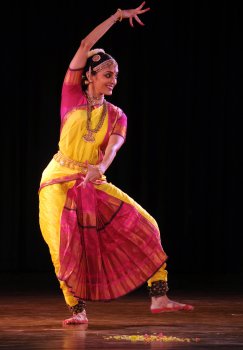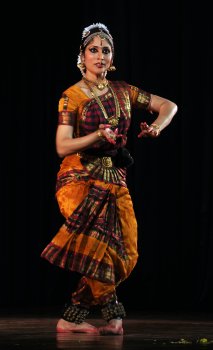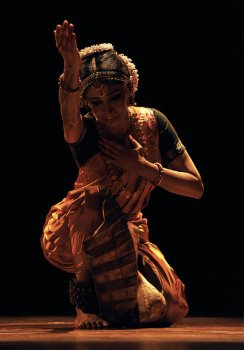
|   |

|   |
Music Academy Dance Festival: Day 2 - Veejay Sai e-mail: vs.veejaysai@gmail.com January 16, 2014 Refreshing artistry The second day morning opened with a solo recital of Lakshmi Parthasarathy Athreya, a student of Guru Chitra Visweswaran. ‘A flickering flame’ is a description that best fits Lakshmi. We’ll see how and why.  Lakshmi Parthasarathy Athreya Photo: Thanthoni The curtains opened to the melodious voice of Murali Parthasarathy singing an invocation. This was followed by Mallari in ragam Ghambira Nattai in sankeerna triputa talam. Guru Chitra’s fantastic choreography came through in her clever infusion of the chollus with the jatis of the piece. Lakshmi, dressed in bright yellow, reminded one of a young Malavika Sarukkai. Vibrant with energy oozing at every aradhi, she kept our attention locked from the beginning. Following that with “Bhavaye Gopabalam bhuvanatraya palam,” an alarippu set to ragam Pushpalatika and rupaka talam, a composition of Maharaja Swati Thirunal, once again Chitra’s choreography weaved its magic. For the main piece of her presentation, Lakshmi chose the famous pada varnam “Innum en manam,” composed by the late violin maestro Lalgudi G Jayaraman set to ragam Charukesi. One got more than a glimpse of Lakshmi’s dance, the excellence of which came through in the long Vazhuvoor jatis her guru was chanting on the nattuvangam. Chitra knows how exactly to utilize such a large space of the academy stage very efficiently through her choreography, unlike many others who perform there. In the sahityam of the anupallavi “Munnampayinradho in natakam ellaam… manna kamala kanna manivanna,” the nayika views Krishna seated. The abhinayam could have been crisper than what was presented. Given the emotive nature of a ragam like Charukesi, Lakshmi’s abhinayam fell short of her involvement. This continued in “Kuzhaloodum azhaga kanna,” where Lakshmi got excited and before we knew we could see Krishna’s flute size increase and decrease rapidly. If Lakshmi reworks this varnam in specific, she can add much more of her artistry into it. After the main piece she performed a Pasuram. Portraying the antics of a naughty Krishna, Lakshmi’s abhinayam wasn’t as convincing as it could have been. She then continued into the famous “Thaye Yashoda.” By now she had warmed up enough and her dance out-did the earlier pieces. Depicting the various leelas of Krishna, Lakshmi arrived at a point of being in total command with her performance in the act where Krishna reveals the universe in his mouth to mother Yashoda. It took her this long to reach there. She concluded her recital with ‘Madhurashtakam’ set to ragam Brindavana Saranga and adi talam by Visweswaran. What one must credit Lakshmi for is her genuine attempt. If she works more on her abhinayam and brings about a consistency, we have here a superstar in the making. With all her charm and beauty, Lakshmi certainly has an edge over many other dancers of her time. She easily belongs to the next generation of dancers to watch out for in the coming years. She is like a flickering flame and will take her time to simmer down into a glowing lamp with a mature and consistent glow. Oh Krishna... Janaki Rangarajan’s undeniable stage presence is the first thing one notices when she enters to perform. She is tall, beautiful and with that gait, can conquer the stage, but less can be said of her dance recital this time around.  Janaki Rangarajan Photo: Thanthoni Janaki opened her performance with a slokam in ragam Sindhu Bhairavi and continued that into Adi Shankara’s ‘Nirvanashtakam.’ Set to khanda chapu talam, the choreography of this serene composition came out being too hurried. If the choreography of this can be reworked to bring in more stillness, the true meaning of this composition would shine forth. The second and main item for her performance was the famous Tanjore Quartet varnam “Sadaya ika taala jaalanura” set to ragam Chakravakam. While one can praise her for her clear lines and nritta, in spite of the many flashes of her guru’s Bharatanrityam constantly barging into her otherwise normal dance, Janaki’s abhinayam isn’t the strongest. Added to this was the vocalist Hariprasad’s rather strong and accented pronouncing of the Telugu sahityam. At one point he sang ‘Thummmmmedalaravamulu,’ completely changing the meaning and context of the lyrics. Anyone with a fair literary knowledge of the language would know the difference between ‘Tummeda’ and ‘Thumme,’ one meaning a honeybee and another meaning to sneeze! A stress on the wrong syllable is enough to change the whole meaning. Janaki also missed her talam at several instances. What one saw in the presentation of the varnam was a mixed bag of an item she could have done very well with. If she got rid of her robotic stiffness and the unwarranted elements of sukhalasyam and whatever else she wants to incorporate into her dance, she could be presenting this much better. Janaki continued into the famous Ashtapadi “Kuru Yadu Nandana” set to ragam Behag and mishra chapu talam. The nayika here is one who is flirting with Krishna after a nightlong session of passionate lovemaking. She makes sandal paste and hints to him to apply it on her bosom. One can find a good translation of this in Barbara Stoeller Miller’s scholarly book on the Gita Govindam. For the best version of this, one can always go back and look at what the legendary Kelucharan Mohapatra did in his choreography through Odissi. What Janaki portrayed in all her excitement was to aggressively grind, like one would grind a large amount of chutney, and collect it into a big bowl. Her enacting line by line of the composition fell into a state of obviousness. To go beyond the rehearsed lines and reach a point of creativity is an exercise that takes time. Janaki is a good dancer and she can be much better than this. We hope she concentrates on her abhinayam and gives completeness to her performance. While Hariprasad’s singing was very involved into the mood of the ragam, it stayed strongly disconnected to the dancer’s act on stage. In all this what stood out was the exceptional flute of Sruthi Sagar and the violin by Kalaiarasan. State of oneness The prima donna of Bharatanatyam had a packed hall in anticipation of her performance. Long queues of rasikas waited eagerly outside all the entrance points of the Music Academy hall for the doors to open. In a few minutes, the hall was packed with everyone taking his or her seats. The few who came in late juggled around to find suitable chairs to get the best of what Valli’s performance could offer.  Alarmel Valli Photo: Siddharth Chandrasekar Valli opened her performance with “Sriman Narayana,” a composition of poet saint Annamacharya set to ragam Bouli and adi talam. While the song and lyrics are super-famous amongst the rasikas of Carnatic music, thanks to the endorsement of M S Subbulakshmi throughout her life, Valli added her own touch to the choreography. What is a Valli performance without involving some classic Sangam poetry? One finds a sense of good art in the interdisciplinary nature of it. In this composition Valli chose a verse from Paripadal, and wove it cleverly into her choreography in the stanza that describes Vishnu as ‘Paramapurusha Paraatpara’ or the all-pervading cosmic being. In the verse ‘Theeyinultheral nee,’ the devotee describes Vishnu as the heat in fire, the fragrance in the flower, gem in the stone, truth in the word. It ends, “You are everything and its inner substance too.” This smart incorporation displayed Valli’s scholarship on the subject of Sangam poetry. Set to ragam Gowri Manohari by Prema Ramamurthy, the verse fit perfectly into the rest of the song. For her main item, Valli performed the famous Tanjore Quartet pada varnam “Sarasa ninnu ippudu” set to ragam Kapi and roopaka talam. Performing to the binaries of the sensual and the sacred, Valli displayed the voice of an agonized devotee through this piece. Murali Parthasarathy’s singing paired with Ranjani Ramakrishna’s violin and Sruthi Sagar’s flute added magic to the performance. Valli continued into another of Annamacharya’s compositions set to a Ragamalika and mishra chapu in thisra nadai by Prema Ramamurthy. In “Elinavaadu thaanu,” the swaadheenapathika nayika is an intimate and confident one. Set to softer ragas like Behag, Mohanam and Khamas, the mood helped in accelerating the content. With notions of hierarchy dissolved, the nayika here is equal to her lord. Valli once again portrayed her scholarship in the way she inculcated the doctrine of Advaita through her choreography in this composition. She concluded her recital with a ‘Swaralaya’ in a Ragamalika. Through the melody of ragas like Nalinakanthi, Vasantha and Hamsadhwani, Valli’s dance filled the stage and the hall with much joy. Out for a quick tea break after her performance, a few of us bump into Oliver, an architect from Italy who happened to be passing by Chennai on his way to Pondicherry. He told a few of us how he saw Valli performing twenty five years ago in Rome and when he saw the name, his curiosity got the better of him to come for this Academy performance. His visit to this performance was totally unplanned and he didn’t mind delaying his trip to solve his curiosity. “She looks just the same and dances the same even after so many decades! How does she manage it!” he exclaimed aloud, much to everyone’s amusement. If one’s art can have the same effect on a rasika, even after so long, one has surely achieved a state of oneness with it. Powerful portrayal The last performance for the second day was titled ‘Thouryatrikam’ presented by Mohiniattam dancer Neena Prasad and her group. Opening the presentation with a Chollkattu composed by Madhavan Nampoothiri and ‘Padmanabha Stuti’ of Tyagaraja Bhagavatar, seven of her dancers in all shapes and sizes danced in good synchrony. Trissur Murali Krishnan’s veena accompaniment was excellent in setting the mood from the very beginning of the whole evening’s presentation.  Neena Prasad Photo: Siddharth Chandrasekar Neena is easily one of the finest Mohiniattam dancers in our country in the current times and her choreographic excellence was seen in the next piece she presented. Inspired by the Jnanpeeth award winning Odissi novel ‘Yagnaseni’ by Prathibha Rai, Neena curated ‘Draupadi.’ In the Swargaarohana Parva of Mahabharata, as all the Pandavas and Draupadi are ascending to the heavens, each one falls one by one. Draupadi’s turn comes first; she pens a poignant letter to Krishna, requesting him to grant her the life of a normal woman in rebirth. Set to ragam Latangi, “Sakhe Krishna sakhi, Karunasagara vilasita sumukhi” was performed in the format of a varnam. Neena’s scholarship on the subject was exhibited in her sancharis. From the birth of Draupadi, her marriage to Arjuna in the first half to the more poignant portrayal of Draupadi’s angst in the second where she showed the life of a normal woman – with a single husband, her joyful adolescence, her maturing into motherhood and later frolicking with her grandchildren, Neena’s abhinayam was extraordinary. The production did get a wee bit longer and one felt it could sustain an evening’s program on its own, without being presented alongside other items. Easwar Ramakrishnan’s violin accompaniment, Trissur Krishna Kumar’s edakka added glow to the piece. Following this was a piece in praise of the goddess Tripura Sundari. While Changanacherry Madhavan Nampoothiri’s singing was melodious, it came out a bit odd with his highly accented singing of Sanskrit lyrics in the next item, an Ashtapadi from the Gita Govindam. The agony of Radha telling her Sakhi that she spotted Krishna with another woman was the story of “Samudithamadane.” The singer kept singing “Pravisha Radhe Madhava samee bumm” much to everyone’s amusement. Sanskrit is a sensitive language and a small change in syllable can have drastic effects on the meaning. Neena and her group made a good attempt and one wishes all her dancers carried the same finesse in presentation as her. Veejay Sai is a writer, editor and a culture critic. |